Exploring Tangible and Intangible Heritage and its Resilience as a Basis to Understand the Cultural Landscapes of Saxon Communities in Southern Transylvania (Romania)
Abstract
:1. Introduction
Saxons Communities in Transylvania: Brief History and Features of Their Cultural Landscape
2. Materials and Methods
2.1. Study Area
2.2. Research Methods
- (a)
- Characteristics of their cultural landscape and their tangible and intangible heritage. The responders were asked to name traditional activities practiced in the past (Q2) and to indicate features of Saxon culture still present in their community, with reference both to tangible and intangible heritage (Q3).
- (b)
- Irreversible changes that occurred in the past decades. We asked about the features of Saxon culture that had completely disappeared (Q4) or with uncertain continuity (Q5). A separate question addressed changes in the traditional way of life (Q6).
- (c)
- Threats to traditional elements of Saxon culture. (Q7) referred to transformations which could disturb traditional features.
- (d)
- What could be done to protect/enhance the traditional elements of Saxon culture. The last question (Q8) focused on the potential to revitalize traditional activities, addressing both the involvement of the interviewee and the local authorities.
3. Results
3.1. Outcomes of the Interviews.
3.2. Statistical Approach
4. Discussion
4.1. Loss and Preservation of Saxon Heritage
4.2. High Resilience
4.3. Low Resilience
4.4. Loss of Tangible and Intangible Heritage
4.5. Fostering Resilience of the Saxon Tangible and Intangible Heritage
5. Conclusions
Supplementary Materials
Author Contributions
Acknowledgments
Conflicts of Interest
References
- Milcu, I.A.; Sherren, K.; Hanspacha, J.; Absonc, D.; Fischer, J. Navigating conflicting landscape aspirations: Application of a photo-based Q-method in Transylvania (Central Romania). Land Use Policy 2014, 41, 408–422. [Google Scholar] [CrossRef]
- MA-Millennium Ecosystem Assessment. Ecosystems and Human Well-being: Synthesis Report; Island Press: Washington, DC, USA, 2005. [Google Scholar]
- CoE-Council of Europe. The European Landscape Convention, 2000. Available online: https://www.coe.int/en/web/conventions/full-list/-/conventions/rms/0900001680080621 (accessed on 24 April 2019).
- Palang, H.; Fry, G. Landscape Interfaces: Cultural Heritage in Changing Landscapes; Kluwer Academic Publishers: Dordrecht, The Netherlands, 2003. [Google Scholar]
- Lieskovský, J.; Bürgi, M. Persistence in cultural landscapes: A pan-European analysis. Reg. Environ. Chang. 2017, 18, 175–187. [Google Scholar] [CrossRef]
- Stephenson, J. The cultural values model: An integrated approach to values in landscapes. Landsc. Urban Plan. 2008, 84, 127–139. [Google Scholar] [CrossRef]
- Plieninger, T.; Bieling, C. Resilience-based perspectives to guiding high-nature-value farmland through socioeconomic change. Ecol. Soc. 2013, 18, 1–15. [Google Scholar] [CrossRef]
- UNESCO—United Nations Educational, Scientific and Cultural Organization. Convention for the Safeguarding of the Intangible Cultural Heritage. 2003. Available online: https://ich.unesco.org/en/convention (accessed on 5 January 2018).
- Lekakis, S. Review: Poulios I, 2014. The past in the present. A living heritage approach—Meteora, Athens 2014. AP Online J. Public Archaeol. 2015, 5, 191–202. [Google Scholar] [CrossRef]
- Hiroyuki, K.; Su, Z.; Wonhee, Y.; Qingwen, M. Concerns and opportunities around cultural heritage in east Asian globally important agricultural heritage systems (GIAHS). Sustainability 2018, 10, 1235. [Google Scholar]
- FAO—Food and Agriculture Organization of the United Nations. Globally Important Agricultural Heritage Systems. Combining Agricultural Biodiversity, Resilient Ecosystems, Traditional Farming Practices and Cultural Identity. 2018. Available online: http://www.fao.org/3/i9187en/I9187EN.pdf (accessed on 1 June 2018).
- Haaland, C.; Fry, G.; Peterson, A. Designing farmland for multifunctionality. Landsc. Res. 2011, 36, 41–62. [Google Scholar] [CrossRef]
- Hart, T.J. The Rural Landscape; Johns Hopkins University Press: Baltimore, MD, USA, 1998. [Google Scholar]
- Fellmann, J.D.; Getis, A.; Getis, J. Human Geography. Landscapes of Human Activities; McGraw-Hill Education: New York, NY, USA, 1999. [Google Scholar]
- Antrop, M. Why landscape of the past are important for the future. Landsc. Urban Plan. 2005, 70, 21–34. [Google Scholar] [CrossRef]
- Fisichelli, N.A.; Schuurman, G.W.; Hoffman, C.H. Is “Resilience” maladaptive? Towards an accurate lexicon for climate change adaptation. Environ. Manag. 2016, 57, 753–758. [Google Scholar] [CrossRef]
- Caballero, G.V. Crossing Boundaries: Linking intangible heritage, cultural landscape and identity. In Proceedings of the pagtib-ong: UP Visayas International Conference on Intangible Heritage, Iloilo City, Philippines, 25–26 May 2017. [Google Scholar]
- Bürgi, M.; Plieninger, T.; Palang, H.; Bieling, C. HERCULES Sustainable Futures for Europe’s Heritage in Cultural Landscapes: Tools for Understanding, Managing, and Protecting Landscape Functions and Values. 2016. Available online: http://www.hercules-landscapes.eu/tartalom/HERCULES_WP3_Deliverable_3.3.pdf (accessed on 1 June 2018).
- Pătru-Stupariu, I.; Tudor, C.A.; Stupariu, M.S.; Buttler, A.; Peringer, A. Landscape persistence and stakeholder perspectives: The case of Romania’s Carpathians. Appl. Geogr. 2016, 69, 87–98. [Google Scholar] [CrossRef]
- Walker, B.H.; Gunderson, L.H.; Kinzig, A.P. A handful of heuristics and some propositions for understanding resilience in social–ecological systems. Ecol. Soc. 2006, 11, 1–15. [Google Scholar] [CrossRef]
- Oteros-Rozas, E.; Gonzales, J.; Lopez, M.; Lopez, C.; Montes, C. Ecosystem services and social–ecological resilience in transhumance cultural landscapes: Learning from the past, looking for a future. In Resilience and the Cultural Landscape. Understanding and Managing Change in Human-Shaped Environments; Plieninger, T., Bieling, C., Eds.; Cambridge University Press: Cambridge, UK, 2012; pp. 242–260. [Google Scholar]
- Plieninger, T.; Höchtl, F.; Spek, T. Traditional land-use and nature conservation in European rural landscapes. Environ. Sci. Policy 2006, 9, 317–321. [Google Scholar] [CrossRef]
- Bürgi, M.; Hersperger, A.; Schneeberger, N. Driving forces of landscape change—Current and new directions. Landsc. Ecol. 2004, 19, 857–868. [Google Scholar] [CrossRef]
- Plieninger, T.; Draux, H.; Fagerholm, N.; Bieling, C.; Bürgi, M.; Kizos, T.; Kuemmerle, T.; Primdahl, J.; Verburg, P.H. The driving forces of landscape change in Europe: A systematic review of the evidence. Land Use Policy 2016, 57, 204–214. [Google Scholar] [CrossRef] [Green Version]
- Solymosi, K. Indicators for the identification of cultural landscape hotspots in Europe. Landsc. Res. 2011, 36, 3–18. [Google Scholar] [CrossRef]
- Szabó, P.; Šipoš, J.; Müllerová, J. Township boundaries and the colonization of the Moravian landscape. J. Hist. Geogr. 2017, 57, 89–99. [Google Scholar] [CrossRef]
- Grimm, G.; Zack, K. Die Deutschen in Ostmittel- und Südosteuropa; Band 1 und 2.; Verlag Südostdeutsches Kulturwerk: München, Germany, 1995; pp. 15–16. (In German) [Google Scholar]
- Wagner, F.P. Der Wandel der Lebensverhältnisse in Rumänien nach Ceausescu. In Lebensverhältnisse in Osteuropa. Prekäre Entwicklungen und Neue Konturen; Glatzer, W., Ed.; Campus Verlag: Frankfurt am Main, Germany, 1996; pp. 211–235. (In German) [Google Scholar]
- Philippi, P. Cuvânt înainte. In Deportarea Etnicilor Germani din România în Uniunea Sovietică–1945; The Honterus Typography: Sibiu, Romania, 1994; pp. 5–14. (In Romanian) [Google Scholar]
- Weber, G. Beharrung und einfügung. Eine Empirisch-Soziologische. Analyse Dreier Siedlungen; Studia Transylvanica, Band 1; Böhlau Verlag: Köln, Germany, 1968. [Google Scholar]
- Poledna, R. Transformări Sociale la Saşii Ardeleni După 194; Presa Universitara Clujeana: Cluj, Romania, 2001. (In Romanian) [Google Scholar]
- Toeroek, B.Z. Managing the past in urban portraitures in fin-de-siecle Saxon Transylvania. J. Urban Hist. 2017, 43, 651–660. [Google Scholar] [CrossRef]
- Akeroyd, J.R.; Page, N. The Saxon villages of Southern Transylvania: Conserving biodiversity in a historic landscape. In Nature Conservation: Concepts and Practice. Akeroyd, J.R., Gafta, D., Eds.; Springer: New York, NY, USA, 2004; pp. 199–210. [Google Scholar]
- ICOMOS—International Council on Monuments and Sites. Villages in Romania, no.596 bis, Advisory Body Evaluation. 1999. Available online: http://whc.unesco.org/en/list/596/documents/ (accessed on 29 January 2019).
- UNESCO—United Nations Educational, Scientific and Cultural Organization. UNESCO World Heritage List. 2010. Available online: http://whc.unesco.org/en/list/596/documents/ (accessed on 11 January 2019).
- Ciobanel, I.A.; Drogeanu, P. Habitat Transylvania; Etnologica Publishing House: Bucharest, Romania, 2011; Volume III. [Google Scholar]
- Clipa, N. Political Economics; Sedcom Libris Publishing House: Iasi, Romania, 1999. [Google Scholar]
- Schubert, H.A. Nachbarschaft, Entfremdung und Protest. Welche Chancen Haben Gemeinschaftsinitiativen in Modernen Gesellschaften? Verlag Karl Alber: Freiburg, Germany, 1977. (In German) [Google Scholar]
- Koranyi, J.; Wittlinger, R. From diaspora to diaspora: The case of Transylvanian Saxons in Romania and Germany. Natl. Ethnic Politics 2011, 17, 96–115. [Google Scholar] [CrossRef]
- Wolff, S. The Politics of Homeland: Irredentism and recognition in the policies of german federal governments and expellee organizations toward ethnic German minorities in Central and Eastern Europe, 1949–1999. In The Heimat Abroad: The Boundaries of Germaneness; O’Donnell, K., Bridenthal, R., Reagin, N., Eds.; The University of Michigan Press: Ann Arbor, MI, USA, 2005; pp. 287–313. [Google Scholar]
- Roth, H. Kleine Geschichte Siebenbürgens; Böhlau: Köln, Germany, 2003. (In German) [Google Scholar]
- Akeroyd, J. The Historical Landscape of Saxon Villages in Southern Transylvania; Art Group: Bucharest, Romania, 2006. [Google Scholar]
- Varga, E.A. Brassó Megye Településeinek Etnikai (anyanyelvi/nemzetiségi) Adatai, 1850–2002. 2002. Available online: http://www.kia.hu/konyvtar/erdely/erd2002/bvetn02.pdf (accessed on 6 February 2019). (In Hungarian).
- Nägler, T. Evoluţia demografică a Biertanului. Acta Terrae Septemcastrensis 2003, II, 167–175. (In Romanian) [Google Scholar]
- NIS—National Institute of Statistics, Brasov County Statistics Office. Territorial Directory of Braşov County 2009–2015; Nis: Braşov, Romania, 2015; pp. 239–242. [Google Scholar]
- Gill, P.; Stewart, K.; Treasure, E.; Chadwick, B. Methods of data collection in qualitative research: Interviews and focus groups. Brit. Dent. J. 2008, 204, 291–295. [Google Scholar] [CrossRef]
- Dörnyei, Z. Research Methods in Applied Linguistics: Quantitative Qualitative and Mixed Methodologies; Oxford University Press: New York, NY, USA, 2007. [Google Scholar]
- Rencher, A. Methods of Multivariate Analysis; John Wiley & Sons: New York, NY, USA, 2002. [Google Scholar]
- Legendre, P.; Legendre, L. Numerical Ecology, 2nd ed.; Elsevier Science: Amsterdam, The Netherlands, 1999. [Google Scholar]
- Greenacre, M. Correspondence Analysis in Practice; CRC Press: Boca Raton, FL, USA, 2010. [Google Scholar]
- Niță, A.; Buttler, A.; Rozylowicz, L.; Pătru-Stupariu, I. Perception and use of landscape concepts in the procedure of Environmental Impact Assessment; case study–Switzerland and Romania. Land Use Policy 2015, 44, 145–152. [Google Scholar] [CrossRef]
- Oksanen, J. Multivariate Analysis of Ecological Communities in R: Vegan Tutorial. 2015. Available online: http://cc.oulu.fi/~jarioksa/opetus/metodi/vegantutor.pdf (accessed on 5 January 2018).
- Torondel, B.; Ensink, J.H.J.; Gundogdu, O.; Ijaz, U.Z.; Parkhill, J.; Abdelahi, F.; Nguyen, V.-A.; Sudgen, S.; Gibson, W.; Walker, A.W.; et al. Assessment of the influence of intrinsic environmental and geographical factors on the bacterial ecology. Microb. Biotechnol. 2016, 9, 209–223. [Google Scholar] [CrossRef] [PubMed]
- Süssner, H. Still yearning for the lost Heimat? Ethnic German expellees and the politics of belonging. In ECPR Conference; Philipps-Universität: Marburg, Germany, 2003. [Google Scholar]
- UNESCO—United Nations Educational, Scientific and Cultural Organization. Convention Regarding the Protection of the World, Cultural and Natural Patrimony. 1972. Available online: http://whc.unesco.org/archive/convention-en.pdf (accessed on 29 January 2018).
- Roth, V. Geschichte der Deutschen Baukunst in Siebenbürgen; Heitz: Strasbourg, France, 1905. [Google Scholar]
- Rosemann, R.; Tartlau, H. Kirchenburg, în Die Deutsche Kunst in Siebenbürgen; Verlag nicht ermittelbar: Berlin, Germany, 1934; pp. 70–72. [Google Scholar]
- Mitchell, N.; Rössler, M.; Tricaud, P.M. Paysages Culturels du Patrimoine Mondial; UNESCO: Paris, France, 2011. [Google Scholar]
- Fabini, H. The Church—Fortresses of the Transylvanian Saxons; Publishing House Monumenta: Sibiu, Romania, 2007. [Google Scholar]
- RG—Romanian Government. Lege nr. 350 din 6 iulie 2001 Privind Amenajarea Teritoriului şi Urbanismul. 2001. Available online: http://www.cdep.ro/pls/legis/legis_pck.htp_act_text?idt=28561 (accessed on 29 January 2018).
- UNESCO World Heritage List, 1999. Available online: http://whc.unesco.org/en/list/596/documents/ (accessed on 4 May 2018).
- Nypan, T. Safeguarding the Saxon Heritage in Transylvania; PREM Project Final Report; Riksantikvaren: Oslo, Norway, 2006. [Google Scholar]
- Tiplic, I.M. The Fortified Churches of Transylvanian Saxons; Media Print Publishing House: Bucharest, Romania, 2006. [Google Scholar]
- Plieninger, T.; Bieling, C. Resilience and the Cultural Landscape. Understanding and Managing Change in Human-Shaped Environments; Cambridge University Press: Cambridge, UK, 2012. [Google Scholar]
- CIMEC—Institute for Cultural Memory. Historical Monuments Proposed for Restoration, 1996–1998. Bucharest, 1998. Available online: http://cimec.ro/scripts/monumente/id.asp?k=151 (accessed on 28 January 2019).
- Bürgi, M.; Ali, P.; Chowdhury, A.; Heinimann, A.; Hett, C.; Kienast, F.; Kumar Mondal, M.; Raj Upreti, B.; Verburg, P.H. Integrating landscape approach: Closing the gap between theory and application. Sustainability 2017, 9, 1371. [Google Scholar]
- Kizos, T.; Verburg, P.H.; Bürgi, M.; Gounaridis, D.; Plieninger, T.; Bieling, C.; Balatsos, T. From concepts to practice: Combining different approaches to understand drivers of landscape change. Ecol. Soc. 2018, 23, 1–11. [Google Scholar] [CrossRef]
- Bürgi, M.; Bieling, C.; von Hackwitz, K.; Kizos, T.; Lieskovský, J.; Martin, M.G.; McCarthy, S.; Müller, M.; Palang, H.; Plieninger, T.; et al. Processes and driving forces in changing cultural landscapes across Europe. Landsc. Ecol. 2017, 32, 2097–2112. [Google Scholar] [CrossRef] [Green Version]
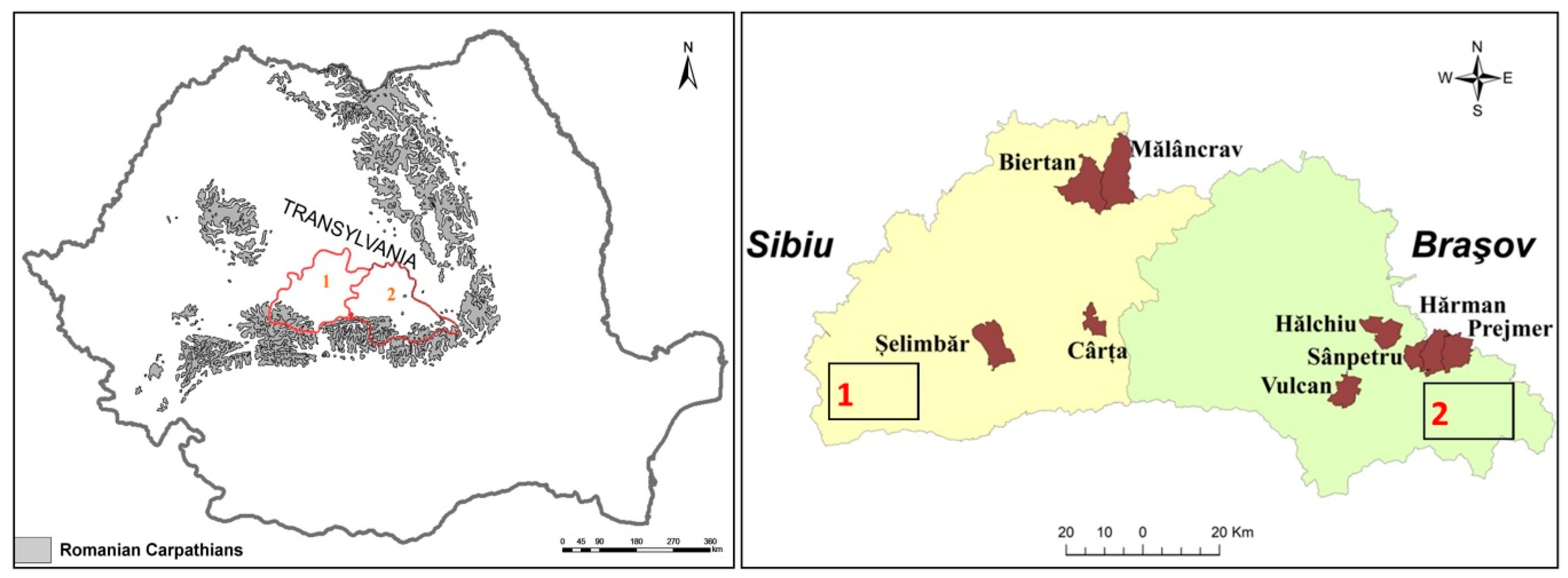
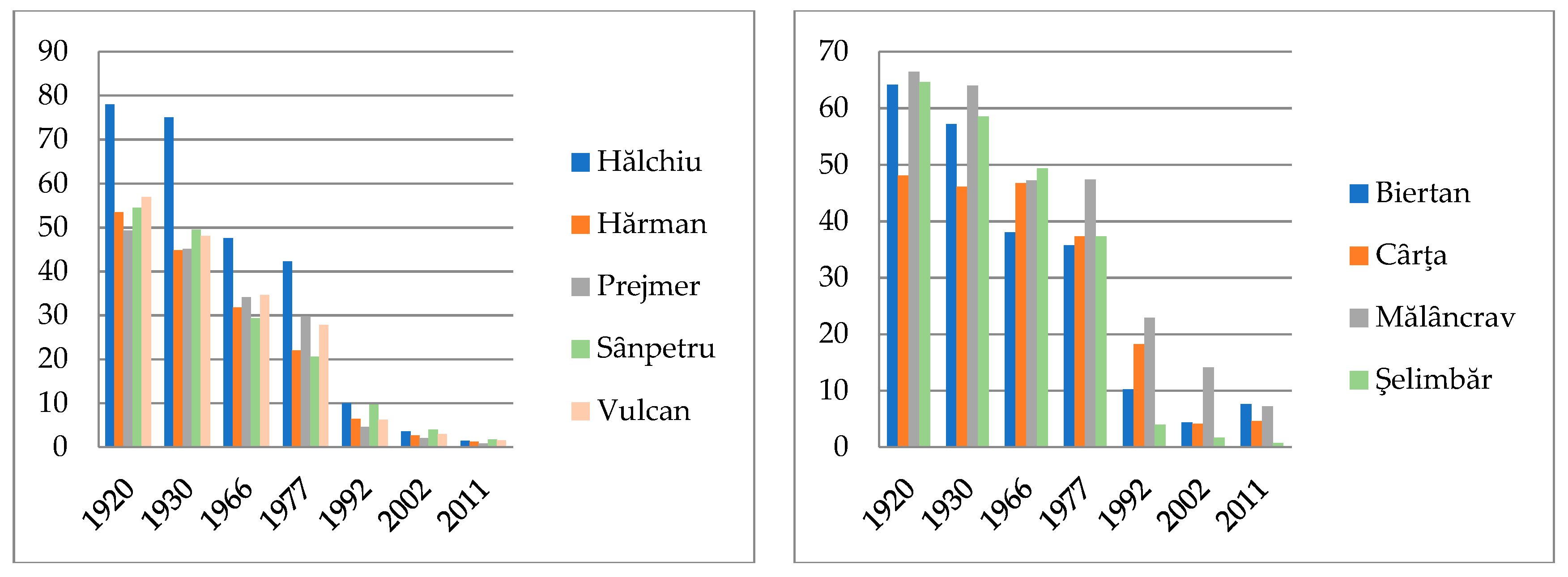

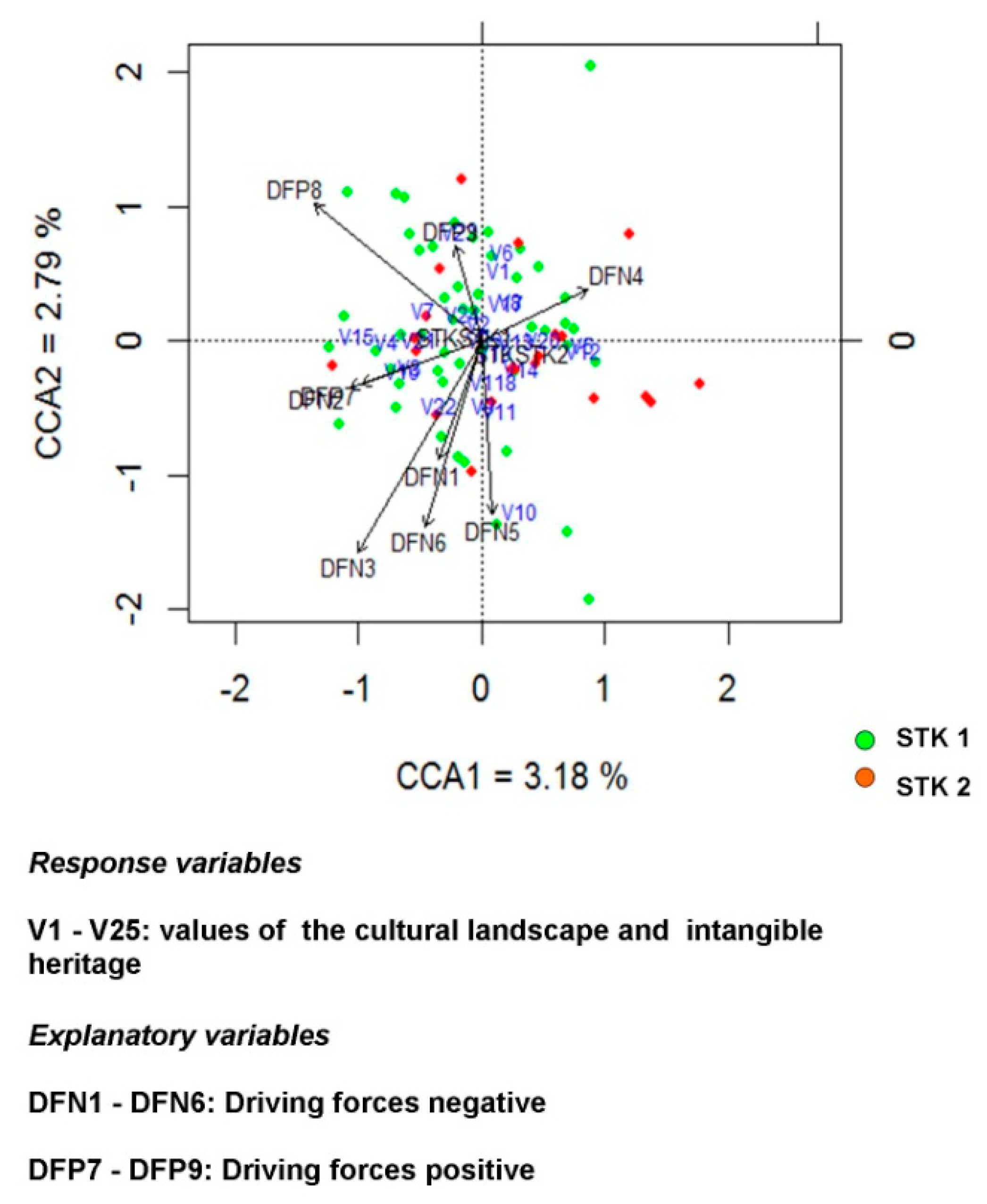
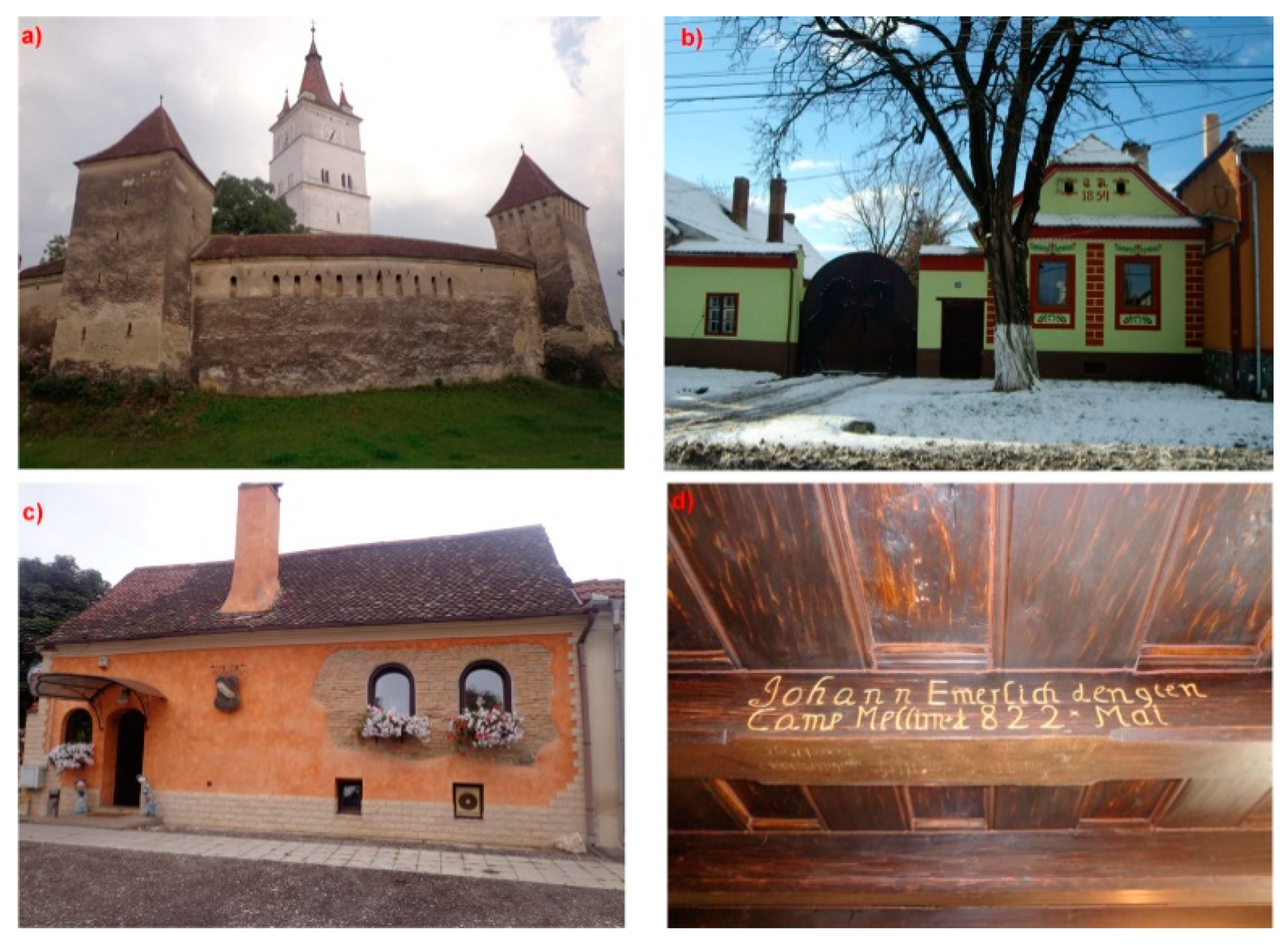
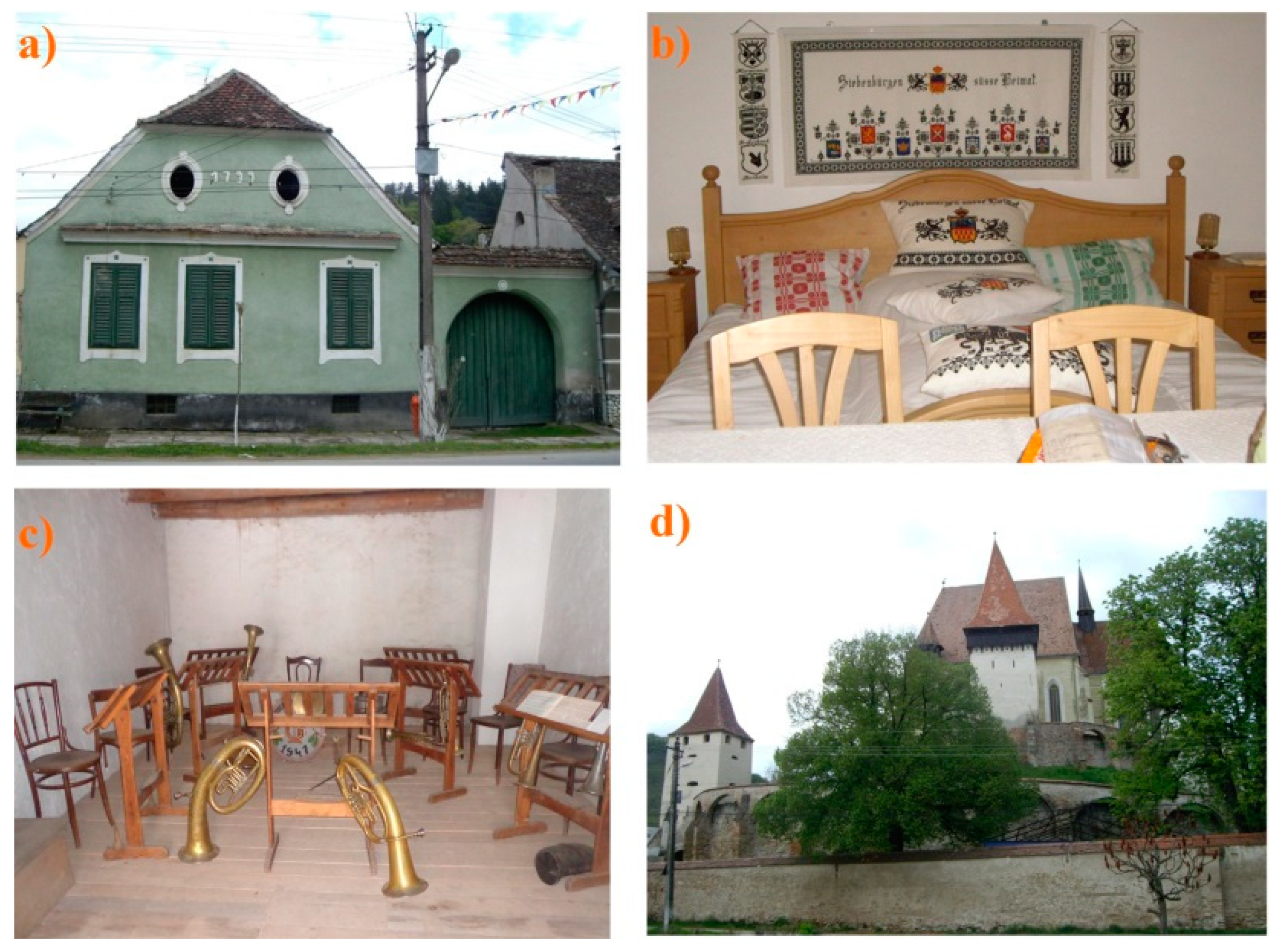
| (a) Villages in Braşov County. | ||||||||||||||||
| Village | Name in Saxon Dialect | Founding Date | 1920 | % | 1930 | % | 1966 | % | 1977 | % | 1992 | % | 2002 | % | 2011 | % |
| Hălchiu | Hältsdref | 1377 | 2171 | 77.92 | 2178 | 75.05 | 1635 | 47.52 | 1582 | 42.27 | 275 | 9.99 | 106 | 3.54 | 61 | 1.44 |
| Hărman | Honigberg | 1240 | 1274 | 53.46 | 1331 | 44.84 | 1162 | 31.83 | 1129 | 21.96 | 242 | 6.45 | 102 | 2.63 | 66 | 1.22 |
| Prejmer | Tartelchen | 1240 | 2090 | 49.30 | 2293 | 45.09 | 1810 | 34.08 | 1741 | 29.73 | 225 | 4.64 | 101 | 2.04 | 71 | 0.83 |
| Sȃnpetru | Pittersbarch | 1240 | 1183 | 54.44 | 1288 | 49.50 | 1103 | 29.32 | 1033 | 20.54 | 319 | 9.64 | 137 | 3.97 | 84 | 1.74 |
| Vulcan | Wulkendref | 1377 | 1152 | 56.97 | 1241 | 48.06 | 1082 | 34.63 | 993 | 27.82 | 199 | 6.17 | 103 | 2.99 | 69 | 1.51 |
| (b) Villages in Sibiu County. | ||||||||||||||||
| Village | Name in Saxon Dialect | Founding Date | 1920 | % | 1930 | % | 1966 | % | 1977 | % | 1992 | % | 2002 | % | 2011 | % |
| Biertan | Biyertan | 1283 | 1232 | 64.16 | 1238 | 57.16 | 811 | 38.02 | 744 | 35.75 | 282 | 10.20 | 130 | 4.34 | 112 | 7.63 |
| Cȃrţa | Kerc | 1202 | 462 | 48.12 | 442 | 46.08 | 488 | 46.74 | 508 | 37.32 | 205 | 18.26 | 47 | 4.15 | 41 | 4.62 |
| Mălȃncrav | Malmkrog | 1305 | 841 | 66.42 | 925 | 63.96 | 711 | 47.21 | 643 | 47.38 | 241 | 22.86 | 145 | 14.11 | 80 | 7.25 |
| Şelimbăr | Schellenberg | 1323 | 601 | 64.62 | 656 | 58.47 | 754 | 49.34 | 834 | 37.33 | 73 | 4.0 | 33 | 1.63 | 51 | 0.72 |
| Inventoried Features | Loss | High Resilience | Low Resilience | |
|---|---|---|---|---|
| Full | On-going | |||
| V1. Traditional Feminine Activities (craft, sewing of traditional clothes) | x | |||
| V2. Crafts practiced by men | x | |||
| V3. House construction techniques | x | |||
| V4. Local manufacturing of bricks | x | |||
| V5. The Saxon educational model | x | |||
| V6. Saxon schools with teaching in the mother tongue | x | |||
| V7. Publications, newspapers, magazines | x | |||
| V8. Traditional cultural–recreational events such as Saint Catherine, recruits’ ball | x | |||
| V9. Culinary recipes | x | |||
| V10. Youth confirmation festivity | x | |||
| V11. Traditional wedding style | x | |||
| V12. Instrumental music bands | x | |||
| V13. Saxon community choirs | x | |||
| V14. Dances and popular songs | x | |||
| V15. Fanfare | x | |||
| V16. Saxon dialect | x | |||
| V17. Equipment/plants | x | |||
| V18. Crops | x | |||
| V19. Animal rearing | x | |||
| V20.The Fashing/Korona Festival | x | |||
| V21. Religious mass | x | |||
| V22. Ceremonies related to the death cult | x | |||
| V23. Religious Easter, Christmas ceremony | x | |||
| V24. Material heritage of the village/old Saxon houses with patrimonial value | x | |||
| V25. Fortified Saxon churches | x | |||
| (a) Land Use. | |
| In the Past | Currently |
| The variety of the crops practiced by the Saxons | Decrease in crop variety:
|
| The three-year rotation of crops | This crop rotation is no longer practiced |
| The Saxons were landlords of high agricultural surfaces, 50–60 ha per family | The plotting of lands and allotment of small surfaces to peasants, which harms productivity |
| Irrigation systems | Disappearance of big irrigation systems |
| Intensive animal rearing | Drastic reduction of livestock and disappearance of buffalo rearing from the tradition |
| Fruit farming: the Saxons processed the fruit and produced juice and apple wine | The present population no longer practices fruit farming and no longer processes the fruit to obtain juice and apple wine |
| The Saxons practiced agriculture and supported a production society | The present population no longer practices agriculture in the tertiary and secondary sector and becomes a consumer society |
| (b) Traditional Activities. | |
| In the Past | Currently |
| Saxon traditional activities: handcrafts | Disturbances of the traditional Saxon activities as a consequence of social dynamics, some practices having completely vanished |
| Agricultural traditional practices | Displacement, some have been undertaken by the cohabitant population |
| House building technique | Alteration, new owners introduce modifications that reshape buildings and divert from original functions |
| Traditional construction materials | Transitions, replacement with new materials that do not preserve the same environmental features |
| Cultural and recreational activities | Changes, the adaptation within the current context, some being further promoted by Romanians for touristic and commercial reasons |
| Culinary traditions | Modification, they are developed by Romanians and Hungarians |
| (c) Socio-Cultural Capital as Determined from the Interviews. | |
| In the Past | Currently |
| The richness of the cultural capital | The cultural capital declines through the disappearance of socio-cultural elements |
| Group cohesion | Decrease in the group cohesion/individualism |
| Cultural diversion—multiculturalism | Decrease in the cultural diversity |
| The traditional landscape had authenticity, identity, and integrity | Disturbances in these variables |
| Driving Forces | Negative Driving Forces (DFN) | Positive Driving Forces (DFP) |
|---|---|---|
| Demographic factor | Saxon migration (DFN1) | Group cohesion: local community and diaspora (DFP7) |
| Political factor | The communist regime (DFN2) Agricultural reform/nationalization (DFN3) | Uncertain property right (DFP9) |
| Economic factor | Evolution of the technique (DFN4) Industrialization (DFN6) | |
| Historical factor | Second World War (DFN5) | |
| External help | Urban planning/UNESCO (DFP8) |
| Response Variables Inventoried Values | Appearance in Interviews | Explanatory Variables | |||||||||
|---|---|---|---|---|---|---|---|---|---|---|---|
| STK1 | STK2 | Driving Forces Negative | Driving Forces Positive | ||||||||
| DFN1 | DFN2 | DFN3 | DFN4 | DFN5 | DFN6 | DFP7 | DFP8 | DFP9 | |||
| V1. Traditional feminine activities (craft, sewing of traditional clothes etc.) | x | x | x | ||||||||
| V2. Crafts practiced by men | x | x | |||||||||
| V3. House construction techniques | x | x | x | ||||||||
| V4. Local manufacturing of bricks | x | ||||||||||
| V5. The Saxon educational model | x | ||||||||||
| V6. Saxon schools (mother language) | x | x | x | x | |||||||
| V7. Publications, newspapers, magazines | x | x | |||||||||
| V8. Traditional cultural/recreational events: Saint Catherine | x | ||||||||||
| V9. Culinary recipes | x | x | x | ||||||||
| V10. Youth confirmation festivity | x | x | |||||||||
| V11. Traditional wedding style | x | x | x | x | |||||||
| V12. Instrumental music bands | x | ||||||||||
| V13. Saxon community choirs | x | x | x | ||||||||
| V14. Dances and popular songs | x | x | x | ||||||||
| V15. Fanfare | x | ||||||||||
| V16. Saxon dialect | x | ||||||||||
| V17. Equipment/plants | x | ||||||||||
| V18. Crops | x | x | x | x | |||||||
| V19. Animal rearing | x | x | x | ||||||||
| V20. The Fashing/Korona Festival | x | x | x | ||||||||
| V21. Religious mass | x | x | x | x | |||||||
| V22. Ceremonies related to the death cult | x | x | |||||||||
| V23. Religious Easter, Christmas ceremony | x | ||||||||||
| V24. Material heritage of the village/old Saxons houses with patrimonial value | x | x | x | ||||||||
| V25. Fortified Saxon churches | x | x | x | ||||||||
© 2019 by the authors. Licensee MDPI, Basel, Switzerland. This article is an open access article distributed under the terms and conditions of the Creative Commons Attribution (CC BY) license (http://creativecommons.org/licenses/by/4.0/).
Share and Cite
Pătru-Stupariu, I.; Pascu, M.; Bürgi, M. Exploring Tangible and Intangible Heritage and its Resilience as a Basis to Understand the Cultural Landscapes of Saxon Communities in Southern Transylvania (Romania). Sustainability 2019, 11, 3102. https://doi.org/10.3390/su11113102
Pătru-Stupariu I, Pascu M, Bürgi M. Exploring Tangible and Intangible Heritage and its Resilience as a Basis to Understand the Cultural Landscapes of Saxon Communities in Southern Transylvania (Romania). Sustainability. 2019; 11(11):3102. https://doi.org/10.3390/su11113102
Chicago/Turabian StylePătru-Stupariu, Ileana, Marioara Pascu, and Matthias Bürgi. 2019. "Exploring Tangible and Intangible Heritage and its Resilience as a Basis to Understand the Cultural Landscapes of Saxon Communities in Southern Transylvania (Romania)" Sustainability 11, no. 11: 3102. https://doi.org/10.3390/su11113102
APA StylePătru-Stupariu, I., Pascu, M., & Bürgi, M. (2019). Exploring Tangible and Intangible Heritage and its Resilience as a Basis to Understand the Cultural Landscapes of Saxon Communities in Southern Transylvania (Romania). Sustainability, 11(11), 3102. https://doi.org/10.3390/su11113102






